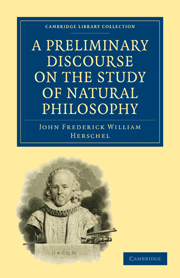Book contents
- Frontmatter
- Contents
- Dedication
- PART I OF THE GENERAL NATURE AND ADVANTAGES OF THE STUDY OF THE PHYSICAL SCIENCES
- PART II OF THE PRINCIPLES ON WHICH PHYSICAL SCIENCE RELIES FOR ITS SUCCESSFUL PROSECUTION, AND THE RULES BY WHICH A SYSTEMATIC EXAMINATION OF NATURE SHOULD BE CONDUCTED, WITH ILLUSTRATIONS OF THEIR INFLUENCE AS EXEMPLIFIED IN THE HISTORY OF ITS PROGRESS
- CHAP. I Of Experience as the Source of our Knowledge. — Of the Dismissal of Prejudices. — Of the Evidence of our Senses
- CHAP. II Of the Analysis of Phenomena
- CHAP. III Of the State of Physical Science in General, previous to the Age of Galileo and Bacon
- CHAP. IV Of the Observation of Facts and the Collection of Instances
- CHAP. V Of the Classification of Natural Objects and Phenomena, and of Nomenclature
- CHAP. VI Of the First Stage of Induction. — The Discovery of Proximate Causes, and Laws of the lowest Degree of Generality, and their Verification
- CHAP. VII Of the higher Degrees of Inductive Generalization, and of the Formation and Verification of Theories
- PART III OF THE SUBDIVISION OF PHYSICS INTO DISTINCT BRANCHES, AND THEIR MUTUAL RELATIONS
- Index
CHAP. V - Of the Classification of Natural Objects and Phenomena, and of Nomenclature
Published online by Cambridge University Press: 29 August 2010
- Frontmatter
- Contents
- Dedication
- PART I OF THE GENERAL NATURE AND ADVANTAGES OF THE STUDY OF THE PHYSICAL SCIENCES
- PART II OF THE PRINCIPLES ON WHICH PHYSICAL SCIENCE RELIES FOR ITS SUCCESSFUL PROSECUTION, AND THE RULES BY WHICH A SYSTEMATIC EXAMINATION OF NATURE SHOULD BE CONDUCTED, WITH ILLUSTRATIONS OF THEIR INFLUENCE AS EXEMPLIFIED IN THE HISTORY OF ITS PROGRESS
- CHAP. I Of Experience as the Source of our Knowledge. — Of the Dismissal of Prejudices. — Of the Evidence of our Senses
- CHAP. II Of the Analysis of Phenomena
- CHAP. III Of the State of Physical Science in General, previous to the Age of Galileo and Bacon
- CHAP. IV Of the Observation of Facts and the Collection of Instances
- CHAP. V Of the Classification of Natural Objects and Phenomena, and of Nomenclature
- CHAP. VI Of the First Stage of Induction. — The Discovery of Proximate Causes, and Laws of the lowest Degree of Generality, and their Verification
- CHAP. VII Of the higher Degrees of Inductive Generalization, and of the Formation and Verification of Theories
- PART III OF THE SUBDIVISION OF PHYSICS INTO DISTINCT BRANCHES, AND THEIR MUTUAL RELATIONS
- Index
Summary
(129.) The number and variety of objects and relations which the observation of nature brings before us are so great as to distract the attention, unless assisted and methodized by such judicious distribution of them in classes as shall limit our view to a few at a time, or to groups so bound together by general resemblances that, for the immediate purpose for which we consider them, they may be regarded as individuals. Before we can enter into any thing which deserves to be called a general and systematic view of nature, it is necessary that we should possess an enumeration, if not complete, at least of considerable extent, of her materials and combinations; and that those which appear in any degree important should be distinguished by names which may not only tend to fix them in our recollection, but may constitute, as it were, nuclei or centres, about which information may collect into masses. The imposition of a name on any subject of contemplation, be it a material object, a phenomenon of nature, or a group of facts and relations, looked upon in a peculiar point of view, is an epoch in its history of great importance. It not only enables us readily to refer to it in conversation or writing, without circumlocution, but, what is of more consequence, it gives it a recognized existence in our own minds, as a matter for separate and peculiar consideration; places it on a list for examination; and renders it a head or title, under which information of various descriptions may be arranged; and, in consequence, fits it to perform the office of a connecting link between all the subjects to which such information may refer.
Information
- Type
- Chapter
- Information
- A Preliminary Discourse on the Study of Natural Philosophy , pp. 135 - 143Publisher: Cambridge University PressPrint publication year: 2009First published in: 1830
